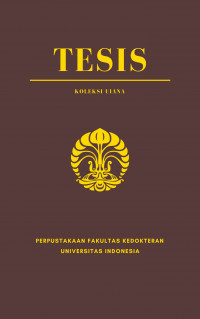Tesis
Diameter Arteri Brakialis dan Vena Sefalika sebagai Prediktor Maturasi Fistula Arteriovenosa Brakiosefalika pada Pasien Gagal Ginjal Tahap Akhir dengan Diabetes Melitus Tipe 2 = Brachial Artery and Cephalic Vein Diameter as Maturation Predictors of Brachiocephalic Arteriovenous Fistula in End Stage Renal Diseases with Type 2 Diabetes Mellitus.
Latar Belakang: Saat ini fistula arteriovenosa (FAV) masih merupakan standar baku emas akses vaskular untuk hemodialisis pada pasien PGTA. Tingginya angka diabetes melitus sebagai penyebab ataupun sebagai komorbid pasien PGTA, tingginya angka kegagalan maturasi FAV terutama pada pasien DM, dan dibutuhkan waktu lebih lama untuk maturasi pada pasien DM. Tujuan: Menganalisis ulang untuk mendapatkan anjuran batas minimal diameter arteri brakialis dan vena sefalika sebagai prediktor maturasi FAV brakiosefalika pada populasi pasien PGTA dengan diabetes melitus tipe 2 pasca pembuatan FAV 6 minggu dan 8 minggu. Metode: Desain yang digunakan adalah kohort retrospektif menggunakan data sekunder. Data sekunder yang digunakan merupakan data dari pasien penyakit ginjal tahap akhir dengan komorbid diabetes melitus tipe 2 yang menjalani operasi pembuatan fistula arteriovenosa brakiosefalika. Hasil: Dari total 72 pasien yang memenuhi kriteria inklusi dan eksklusi, terdapat 44 (61,11%) pasien yang mengalami matur pada 6 minggu post operasi dan 47 (65,28%) yang matur pada 8 minggu post operasi. Matur minggu ke 6 memiliki diameter vena sefalika yang bermakna lebih besar daripada yang tidak matur (3,20±0,94 vs 2,65±1,02, p=0,002). Pada minggu ke 8 didapatkan diameter arteri brakialis bermakna lebih besar daripada tidak matur (4,22±0,70 vs 3,78±0,60, p=0,012), dan memiliki diameter vena sefalika bermakna lebih besar daripada tidak matur (3,28±0,98 vs 2,43±0,82, p=0,000). Nilai prediksi dari diameter arteri brakialis pre operasi untuk memprediksi maturasi FAV Brakiosefalika sebesar 68% (IK 95%: 55,1%-80,9%) untuk minggu ke 8. Nilai prediksi dari diameter vena sefalika pre operasi untuk memprediksi maturasi FAV Brakiosefalika sebesar 71,7% (IK 95%: 58,7%-84,7%) untuk minggu ke 6 dan 79,8% (IK 95%: 68,2%-91,3%) untuk minggu ke 8. Kesimpulan: Nilai ambang terbaik untuk diameter arteri brakialis pre operasi memprediksi maturasi FAV minggu ke 8. adalah 3,85 mm (sensitivitas 78,7% dan spesifisitas 60%). Nilai ambang terbaik untuk diameter vena sefalika pre operasi memprediksi maturasi FAV minggu ke 6 adalah 2,45 mm (sensitivitas 79,5% dan spesifisitas 60,7%), dan nilai ambang terbaik untuk diameter vena sefalika pre operasi memprediksi maturasi FAV minggu ke 8. adalah 2,45 mm (sensitivitas 83% dan spesifisitas 72%).
Kata Kunci: Maturasi, fistula arteriovenosa brakiosefalika, diameter arteri brakialis, diameter vena sefalika, hemodialisis, diabetes melitus.
Background: Currently arteriovenous fistula (AVF) is still the gold standard for vascular access for hemodialysis in ESRD patients. The high rate of diabetes mellitus as a cause or as comorbidity in ESRD patients, the high rate of AVF maturation failure, especially in DM patients, and it takes longer time for maturation in DM patients. Objective: To reanalyze to obtain recommendations for the minimum diameter of the bracial artery and cephalic vein as a predictor of brachiocephalic AVF maturation in the ESRD patient population with type 2 diabetes mellitus after 6 weeks and 8 weeks of creation AVF. Method: The design used was a retrospective cohort design using secondary data. The secondary data used are data from patients with ESRD with comorbid type 2 diabetes mellitus who underwent surgery for brachiocephalic AFV. Results: From a total of 72 patients who met the inclusion and exlusion criteria, there were 44 (61,11%) patients who were mature at 6 weeks of postoperatively 47 (65,28%) who were mature at 8 weeks of postoperatively. The 6 th week of maturity had a significantly larger cephalic vein diameter than the immature (3,20±0,94 vs 2,65±1,02, p=0,002). The 8 th week of maturity had a significantly larger brachial artery diameter than the immature (4,22±0,70 vs 3,78±0,60, p=0,012), and having a cephalic vein diameter significantly larger than the immature (3,28±0,98 vs 2,43±0,82, p=0,000). The predictive value of preoperative brachial artery diameter to predict brachiocephalic AVF maturation was 68% (95% CI: 55,1%-80,9%) for week 8. The predictive value of preoperative cephalic vein diameter to predict brachiocephalic AVF maturation was 71,7% (95% CI: 58,7%-84,7%) for week 6 and 79,8% (95% CI: 68,2%-91,3%) for week 8. Conclusion: The best threshold value for preoperative brachial artery diameter predicting AVF maturation 8 th week was 3,85 mm (sensitivity 78,7% and specificity 60%). The best threshold value for preoperative cephalic vein diameter predicting AVF maturation 6 th week was 2,45 mm (sensitivity 79,5% dan specificity 60,7%), and the best threshold value for preoperative cephalic vein diameter predicting AVF maturation 8 th week is 2,45 mm (sensitivity 83% dan specificity 72%).
Keywords: Maturation, brachiocephalic arteriovenous fistula, brachial artery diameter, cephalic vein diameter, hemodialysis, diabetes mellitus.
- Judul Seri
-
-
- Tahun Terbit
-
2021
- Pengarang
-
Ahmad Daenuri - Nama Orang
Dedy Pratama - Nama Orang
Aria Kekalih - Nama Orang - No. Panggil
-
T21123fk
- Penerbit
- Jakarta : Sp-2 Ilmu Bedah Vaskular dan Endovaskular., 2021
- Deskripsi Fisik
-
xiv, 55 hal; ill; 21 x 30 cm
- Bahasa
-
Indonesia
- ISBN/ISSN
-
-
- Klasifikasi
-
NONE
- Edisi
-
-
- Subjek
- Info Detail Spesifik
-
Tanpa Hardcopy
| T21123fk | T21123fk | Perpustakaan FKUI | Tersedia |


Masuk ke area anggota untuk memberikan review tentang koleksi